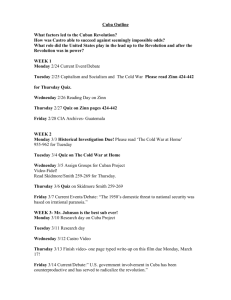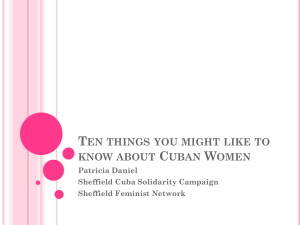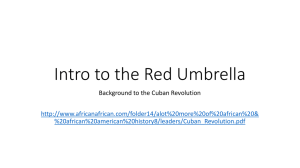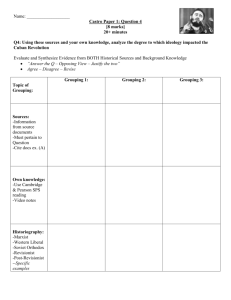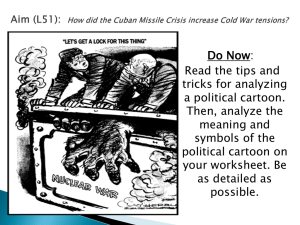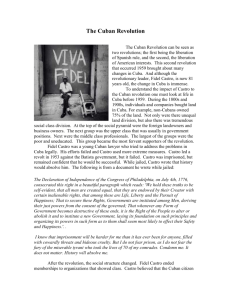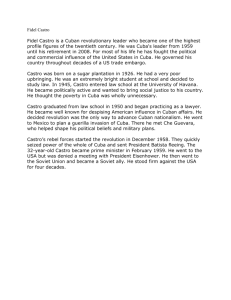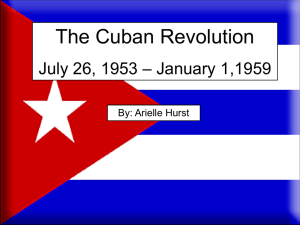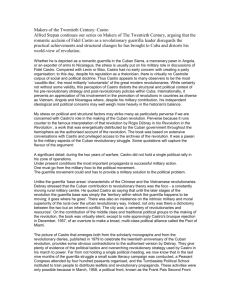Lesson Plan: The Cuban Revolution
advertisement
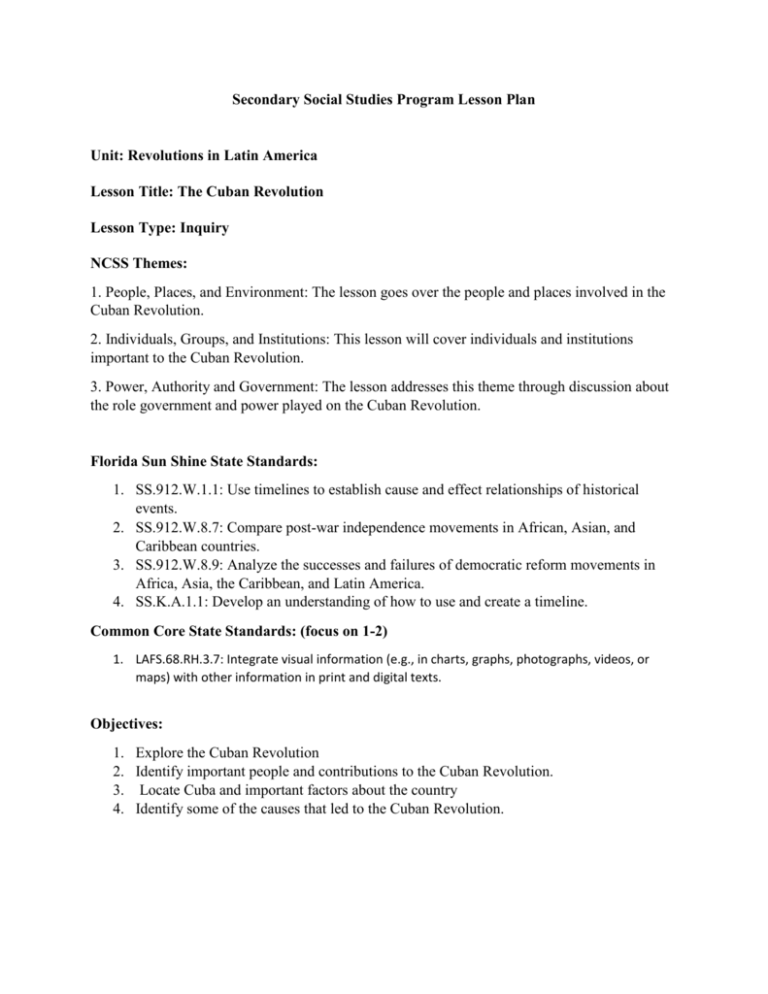
Secondary Social Studies Program Lesson Plan Unit: Revolutions in Latin America Lesson Title: The Cuban Revolution Lesson Type: Inquiry NCSS Themes: 1. People, Places, and Environment: The lesson goes over the people and places involved in the Cuban Revolution. 2. Individuals, Groups, and Institutions: This lesson will cover individuals and institutions important to the Cuban Revolution. 3. Power, Authority and Government: The lesson addresses this theme through discussion about the role government and power played on the Cuban Revolution. Florida Sun Shine State Standards: 1. SS.912.W.1.1: Use timelines to establish cause and effect relationships of historical events. 2. SS.912.W.8.7: Compare post-war independence movements in African, Asian, and Caribbean countries. 3. SS.912.W.8.9: Analyze the successes and failures of democratic reform movements in Africa, Asia, the Caribbean, and Latin America. 4. SS.K.A.1.1: Develop an understanding of how to use and create a timeline. Common Core State Standards: (focus on 1-2) 1. LAFS.68.RH.3.7: Integrate visual information (e.g., in charts, graphs, photographs, videos, or maps) with other information in print and digital texts. Objectives: 1. Explore the Cuban Revolution 2. Identify important people and contributions to the Cuban Revolution. 3. Locate Cuba and important factors about the country 4. Identify some of the causes that led to the Cuban Revolution. Materials/Equipment: 1. 2. 3. 4. 5. Cuban Revolution PowerPoint Video “The Cuban Revolution” Notecard Quizzes Maps *NCSS Conference: This lesson is based on the “A Technology Town Hall for Social Studies Teachers” by Nicholas Lawrence, East Bronx Academy for the Future, Bronx, NY Procedures Lesson Opener or Hook – Engage Show world map and point out Cuba o Ask students what they notice about Cuba’s location. Show map of Cuba o Ask students to tell you what the observe about Cuba (i.e. its an island, has lots of rivers, mountainous, names of cities, capital.) o Ask students to name events in history they associate with Cuba. o Write their answers on the board. Activity One –Video Have students watch video “Cuban Revolution” o https://www.youtube.com/watch?v=vdE6wqo2NOI Activity Two - PowerPoint Slide One – The Cuban Revolution Slide Two – image Slide Three – Fulgencio Batista Slide Four – Fidel Castro Slide Five – image Slide Six – The Revolution Slide Seven – The Revolution cont. Slide Eight – images Activity Three – Quiz Hand out quiz to students. Conclusion: Have students write on a notecard something new they learned today. Modifications: I have made this lesson accessible to all students by providing them with dictionaries, giving clear instruction, and providing visual stimuli. ELL Strategies: This lesson is accessible to ESOL students through the use of dictionaries, and images used throughout the lesson. The students will also be made to feel comfortable asking the teacher to repeat themselves or by coming to the teacher with questions. ESOL students will also be paired up with a bilingual student to help them through the source documents. Lastly, ESOL students will be allowed to use google translate whenever they feel the need. Technology: The use of technology in this lesson is solely in the classroom, so it is accessible to students of all Social-Economic backgrounds. I have incorporated pictures and videos through the use of technology. Quiz: 1. What was the name of Fidel Castro’s brother? a. Paul b. Raul c. Fulgencio d. Jose 2. What year were the presidential elections in Cuba that led to the Cuban Revolution? a. 1978 b. 1962 c. 1952 d. 1980 3. What is a rebel? a. A government official b. A person that is part of an opposing group against a higher power c. Punk rock fan d. Fulgencio Batista 4. What is a coup? a. Illegal seizure of power from a government b. Successful move c. Where chickens live d. Another name for a rebel 5. What was Castro’s original job? a. Trained lawyer b. School teacher c. Navy seal d. Inventor 6. Where did the Castro brothers go to regroup after they were let out of prison? a. Miami, Fl b. Mexico c. Stayed in Cuba d. Texas 7. What caused the revolution? a. Batista taking power when the election results were not in his favor b. The president of the U.S. imposing a trade embargo c. Obama being elected d. Miley Cyrus cutting all her hair off 8. How many coups was Batista part of? a. 1 b. 2 c. 3 d. 4 9. How did the Castro brothers defeat the soldiers? a. By bombing key government places b. By hiding in the mountains c. by killing Batista d. they didn’t 10. What did Fidel Castro do when he became president? a. Freed all the slaves b. Wrote the Cuban constitution c. Established true democracy d. Made himself president for life

